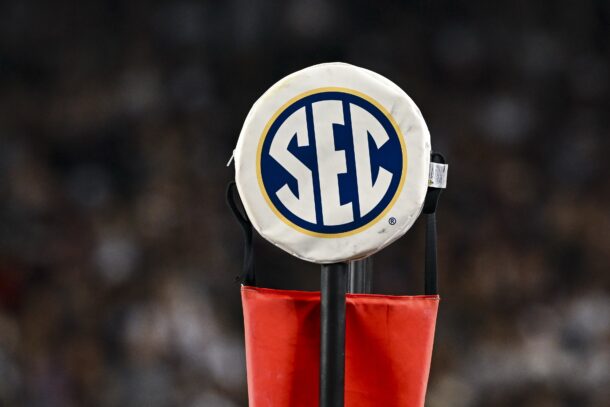
Playoff takeaways: Home fields and higher seeds dominating are the story of Round 1
In retrospect, maybe we should have seen this coming.
As many opening-round blowouts as there were in the old 4-team format, it shouldn’t come as a complete surprise that the first set of games in the expanded 12-team version of the College Football Playoff were anything but competitive.
Remember LSU 63, Oklahoma 28 in 2021?
Or Georgia 34, Michigan 11 3 years ago? How about Clemson’s 31-0 victory over Ohio State in 2016? Or Oregon’s 59-20 whitewashing of FSU in 2014?
This year’s openers weren’t any worse. As it turns out, the game that flipped the switch and set so many people off – Notre Dame’s 27-17 win against Indiana on Friday night – was the closest of the weekend. And that score was 27-3 with 2 minutes left.
The average margin of the 4 games was 19 points.
The results have naturally sparked an outcry that the selection committee got it wrong by putting undeserving teams into the bracket, although that narrative quieted the farther Tennessee fell behind in its 42-17 dismantling at Ohio State.
But when it comes to seeding, an argument can be made that the committee got it right. The higher seed won each of the 4 first games.
That doesn’t necessarily mean that the ACC is an inferior conference or that Indiana should have been dismissed because it didn’t play as difficult a schedule as teams that got left out. It simply means that the better teams won and advanced.
And that if the powers that be in college football are seriously considering further expansion of the Playoff, let this weekend’s games serve as a reminder to them to just say no.
With that, here are some takeaways from the inaugural games of the 12-team Playoff era:
Campus venues were the best thing about the weekend
OK, so the games were all dogs.
But the atmosphere was spectacular.
You can debate all you like over the format that awards byes to the top 4-ranked conference champions or the criteria used by the selection committee to select at-large teams. But it’s hard to argue with the decision to hold these opening-round matchups on the home fields of the higher seeds.
For one thing, it provided them with a distinct advantage. Especially the 3 that play in cold-weather locations. It’s an advantage they earned with their performances through the regular season.
But beyond the impact on the field of play, the on-campus venues helped create the kind of electric atmosphere a Playoff game deserves. It’s such a good idea that the committee should consider moving quarterfinal games to home stadiums, as well, in the future.
Forget those antiseptic, indoor neutral sites with stands left half-empty because fans were saving their money for possible later-round trips. From the fireworks leading up to kickoff at Notre Dame to the white-out at Penn State to the stadium-shaking roars at Texas and Ohio State, there was plenty to be excited about this weekend.
Even though the games themselves weren’t exciting, well, unless you were cheering for the home team.
The most impressive first-round winner was …
It’s a toss-up between Texas and Ohio State.
The 5th-seeded Longhorns came into Saturday’s contest against No. 12 Clemson fielding some legitimate questions about a sputtering offense that had managed fewer than 21 points in 3 of its 4 previous games.
But after spotting the Tigers an early 7-0 head start, they answered those questions in a big way.
Texas surpassed the 21-point mark in the second quarter alone. It churned out 494 yards of total offense against a solid defense that had only allowed an average of 22 points and 351 yards per game all season.
Although quarterback Quinn Ewers still wasn’t as sharp as early in the year, going 17-of-24 for 202 yards, 1 touchdown and an interception, he didn’t have to be with a ground game that gashed Clemson for 292 yards.
The 38-24 win sends the Longhorns into a New Year’s Day quarterfinal against No. 4 Arizona State in the Peach Bowl.
The 8th-seeded Buckeyes, meanwhile, earned a Jan. 1 rematch with top-seeded Oregon at the Rose Bowl with a dominating 42-17 beatdown of No 9 Tennessee. In the process, they erased much of the doubt they created for themselves in their annual loss to rival Michigan on the final Saturday of the regular season.
OSU took at least a little bit of heat off coach Ryan Day by scoring touchdowns on their first 3 possessions to jump to a quick 21-0 lead and never looked back. As impressive as the Buckeyes were offensively, their defense was even better.
It certainly helped that Tennessee star Dylan Sampson was bothered by a hamstring injury that limited him to 6 yards on only 2 carries. But OSU showed why it leads the nation in scoring and total defense by sacking quarterback Nico Iamaleava 4 times and holding the normally high-powered Vols to a single touchdown until a window-dressing score with just under 2 minutes remaining.
The most disappointing first-round loser was …
The aforementioned Vols.
Sure, SMU was self-destructively bad against No. 6 Penn State. And Indiana looked overmatched against No. 7 Notre Dame. But not a lot was expected from either newcomer to the national stage.
Tennessee is a different story. Josh Heupel’s team may have been a slight underdog against the Buckeyes, but they at least figured to put up a fight given their SEC pedigree and win against Playoff wannabe Alabama.
But the Vols had no answer for Will Howard and an OSU offense that dropped a season-high 473 yards on them. And their offense, as mentioned, went nowhere fast without Sampson’s 1,485 yards and 22 touchdowns in the backfield.
Did SMU and Indiana belong?
This isn’t going to go over well with fans of Alabama, Ole Miss, South Carolina and maybe even Miami. The first 4 teams out. But losing a game on the road against a higher-seeded team isn’t a reason to dismiss the Mustangs and Hoosiers as frauds. Just as a win by either wouldn’t have validated their selection by the Playoff Committee.
The most compelling argument for expanding the tournament from 4 teams to 12 is that it gives more teams than just the usual suspects an opportunity to compete for a national championship. The inclusion of SMU and Indiana in the field accomplished exactly that. Will there be tweaks in “data points” used in the selection process? Probably. It’s possible to appreciate a breakthrough season (Indiana) while also taking a closer look at how difficult it was to achieve that success.
The bigger problem with inviting newcomers into the national spotlight is that they often end up suffering from a case of stage fright once they get there. And the moment proved too big for the Mustangs and Hoosiers.
In the case of SMU, it was quarterback Kevin Jennings who cracked under the pressure by missing an early opportunity to put his team ahead by throwing incomplete to a wide-open receiver on a 4th-down play, then compounding the problem by throwing a pair of pick-6s that took his team out of contention by halftime.
For Indiana, aside from not having as much talent as Notre Dame, the weak link was Curt Cignetti. The usually brash coach was nowhere near as aggressive in his game planning as he was with his posturing before Selection Sunday and again before Friday’s game at Notre Dame. His passiveness was best summed up by his decision to punt rather than go for it on 4th down from midfield with his team trailing by 17 early in the 4th quarter.
Would it have made a difference had he rolled the dice and picked up a first down?
We’ll never know. But the message he sent his team by playing it safe in that situation was one of a coach more interested in keeping the score respectable than trying to win the game.
Award-winning columnist Brett Friedlander has covered the ACC and college basketball since the 1980s.







